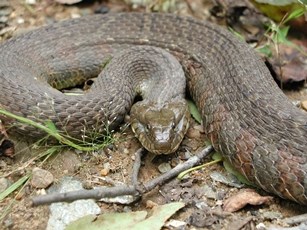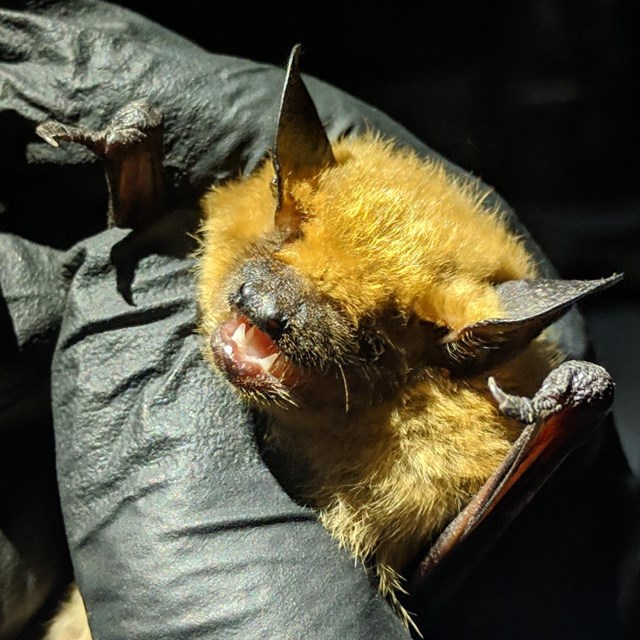|
Reptiles and amphibians are important components of the ecosystem around the park, providing a significant contribution to the food web. Snakes, turtles, and lizards help to control the rodent, fish, and insect populations while frogs, toads, and salamanders aid in the movement of nutrients on the forest floor by eating the insects and invertebrates that inhabit it. They also contribute to the food web by serving as prey for larger animals, providing energy and nutrients to these higher levels of the food chain. Because of the sensitivity of amphibians’ skin, and the sensitivity of reptiles to changes in temperature, these species can indicate the health of the ecosystem and aid park sta^ in identifying potential threats to address.
Please enjoy and observe wild animals from a distance. Watch your step on trails and the towpath and be aware of your surroundings. Snakes will generally avoid people and may sit still when people are nearby so they are not easily detected.
ReptilesReptiles are ectothermic animals, meaning they use energy from the sun to warm their bodies. Their skin is covered in scales, which can help distinguish them from amphibians. Within the C&O Canal, there are ten snake species that occupy aquatic to forested habitat, three species of lizards that can be seen darting up a tree or across sunny rocks, and at least eight species of turtles. Several of the most common species of the Park's reptiles are listed below. 
National Park Service The northern water snake is a very common, non-venomous species throughout the park,with the Potomac River banks and the many sections of canal that hold water providing an ideal habitat. This species is a thicker-bodied snake with varying color and patterns. They are generally light to dark brown with faded reddish-brown bands across the body. These snakes often feed on fish and crayfish and can be seen swimming underwater with just their head above the surface. They are commonly mistaken with the venomous Cottonmouth (Agkistrodon piscivorous), which does not inhabit the C&O Canal.

National Park Service Eastern Ratsnakes are large, non-venomous snakes found in abundance throughout the park. Juvenile snakes have a blotched brown/black pattern while the adult snake has black scales disrupted by a lighter gray color. These snakes are named for their tendency to prey on rodents, which may can help maintain rodent populations to help control rodent populations throughout the landscape. They are excellent climbers and can often be seen sunbathing on the branches of trees.They are excellent climbers and can often be seen sunbathing on the branches of trees.

NPS/Miranda McCleaf The garter snake is abundant throughout the park, preferring moist grassy environments and permanent surface water. This species typically has a olive brownish-greenish base color with a cream to yellow stripe running down the length of its back, darkly mottled scales and a light cream colored underside. This species' primary diet is fish and invertebrates, however it will feed opportunistically on larger prey. This species is very similar in appearance to the common ribbonsnake, which is much more aquatic than the garter snake. When handled or threatened, they may release a foul smelling musk to ward o^ predators.

NPS Photo Eastern snapping turtles are a common find throughout the C&O Canal. As its name suggests, these turtles have a long neck, quick reaction, and won't hesitate to snap at an attacker. These large reptiles are almost exclusively aquatic: they occupy the canal and the Potomac River except for land travel during the spring and early summer for mating and nesting. Snapping turtles can be identified by their flat oval brown shell, wide flat head, bulky limbs and a long alligator-like tail. After hatching during late summer and early fall, baby snapping turtles may be seen making the trek to the water. These baby turtles should not be moved or assisted in this process, as this can disorient them.

NPS/Miranda McCleaf Basking turtles are a frequent sight throughout the canal and in slow-moving or still portions of the river where they can be viewed swimming and sunning themselves on logs or rocks. These turtles rarely ever leave the water except for nesting in the spring and early summer. Eastern Painted Turtles (Chrysemys picta picta) occupy the C&O Canal and are identified by their olive-brown to black shells and yellow to red stripes on the head, neck, and limbs. Similar species include the non-native Red Eared Slider (Trachemys scripta elegans), and native Northern Red-Bellied Cooter (Pseudemys rubriventris) which both grow to be slightly larger than Painted Turtles. The presence of a red oval-shaped marking behind the eye helps identify Red Eared Sliders from the narrower yellow lines on the Red-Bellied Cooter's head.

NPS/Gerald Elkin Eastern box turtles are the most terrestrial turtle native to the C&O Canal. They are named for their boxy, high-domed shell and they have the ability to close up their body using a hinge on the shell's underside. They can be found throughout the Park, in both forested and open habitat. Like all other turtle species in the C&O Canal, they are most active in the spring and early summer. Box turtles are sexually dimorphic, meaning that males and females display di^erent physical characteristics. Males of this species usually have red eyes and a brightly colored shell, while the females, like the one pictured, have brown eyes and a darker shell.
AmphibiansAmphibians are similar to reptiles in the sense that they use energy from the sun to warm their bodies, but otherwise differ by having thin, moist skin without scales. They also require aquatic environments for laying eggs and often for juvenile development. The C&O Canal provides some great habitat for many amphibian species, due to the many segments of canal that collect water seasonally, producing fish-less wetlands. Frogs and toads belong to one group of amphibians found in the Park, which is characterized by their hind limbs specialized for jumping and ability to call or vocalize. Salamanders, with elongate bodies and tails, compose the other group found in the C&O Canal. Some amphibians will migrate in large groups during spring rain events, after they have emerged from overwintering sites. 
NPS/Miranda McCleaf American bullfrogs can be found around the canal or other water bodies in the park, such as ponds, streams, and the river. American Bullfrogs spend the most time around the canal, ponds, streams and the river. These frogs are very opportunistic feeders and will eat anything that they can fit into their mouths. Bullfrogs can often be heard calling from spring into late summer, sounding almost like race car going around a track. They can be distinguished from the green frog by a lack of dorsolateral ridges.

NPS/Miranda McCleaf Wood Frogs are another common aquatic frog that occur in more wooded habitats of the canal, ponds, and the Potomac River. This species is very cold tolerant and will be the earliest frog to emerge, call, mate and lay eggs in the spring each year. Wood frogs are most easily distinguished by the dark brown mask across the eye, from the nose tip to right above the front leg.

NPS/Miranda McCleaf Some frog species are classified as tree frogs and, although they spend time around seasonal ponds and wetland areas, they have the ability to climb and cling to tall grasses, shrubs and tree trunks. A common tree frog that appears and calls in early spring is the spring peeper. This species is a very small frog, often occurring and calling in large groups in seasonal ponds, and can be easily distinguished by the "X" mark across it's back.

NPS/Miranda McCleaf Gray Treefrogs are a less frequent sight, but are still a common tree frog found within the Park. This species is more arboreal than other frogs found in the C&O Canal, and they inhabit forested pools and wetlands where they call from spring and into summer. Gray Treefrogs can be identified by having gray-brown rough skin, with patterns that imitate tree bark.

NPS/Miranda McCleaf Toads, such as the eastern American toad, occupy the drier portions of the forest floor, commonly in leaf litter or even sandy soils. In general, toads are more terrestrial than the frog species in the Park, and crawl more than they hop while moving. American toads are solitary for the majority of the year, but during spring and summer months they aggregate in ponds to call and mate.
Species checklistSelect a Park:Select a Species Category (optional):
Search results will be displayed here.
Learn more
Explore more |
Last updated: November 21, 2024





